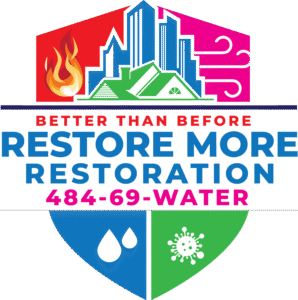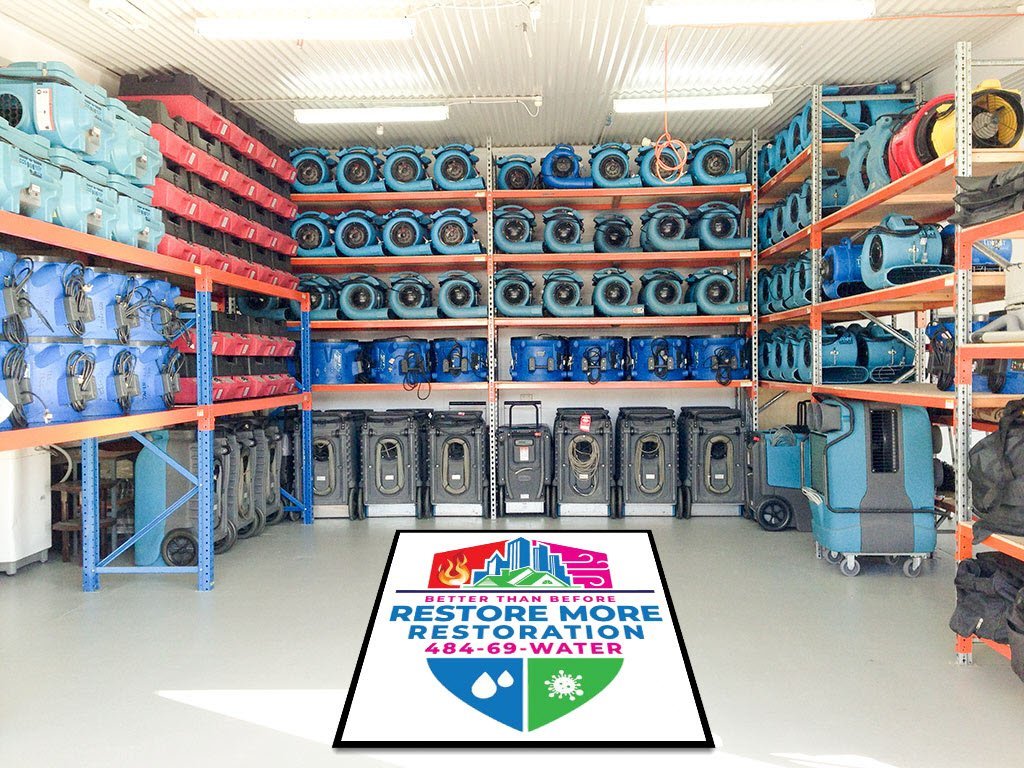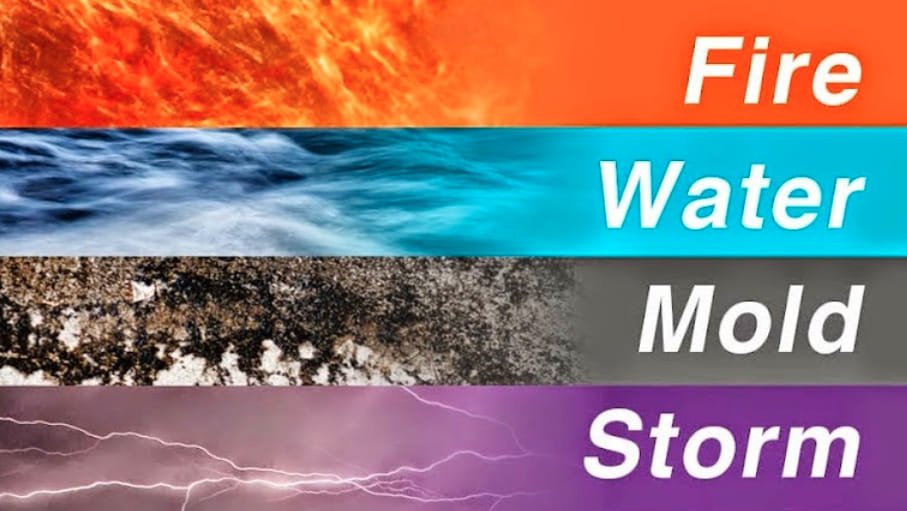Storm Preparedness for Delaware County: Protecting Your Property and Family from Severe Weather
Delaware County’s location in southeastern Pennsylvania places residents in the path of diverse and potentially dangerous weather systems throughout the year. From powerful nor’easters and severe thunderstorms to winter ice storms and occasional tropical weather remnants, our region faces a wide range of meteorological challenges that can cause significant property damage and threaten family safety. Understanding these weather patterns, preparing your property, and developing comprehensive emergency plans can mean the difference between minor inconvenience and catastrophic loss when severe weather strikes.
As water damage restoration experts serving Delaware County communities including Garnet Valley, Concord Township, and surrounding areas, we’ve responded to countless storm-related emergencies and understand the critical importance of preparation. Our partnership with RestoreMore365 has given us extensive experience in storm damage restoration and emergency response, and we’re committed to helping our neighbors prepare for and respond to severe weather events before they become disasters.
Understanding Delaware County’s Weather Patterns and Risks
Delaware County’s geographic location creates a unique convergence of weather systems that can produce severe and rapidly changing conditions. According to the National Hurricane Center, understanding regional weather patterns and seasonal risks is essential for effective emergency preparedness and property protection.
Seasonal Weather Threats
Spring Storm Systems: Spring in Delaware County brings the highest risk of severe thunderstorms, including supercells capable of producing damaging winds, large hail, and tornadoes. The collision of warm, moist air masses from the south with cooler air from the north creates ideal conditions for severe weather development. These storms can produce rainfall rates exceeding 2 inches per hour, leading to flash flooding and rapid water accumulation.
Summer Severe Weather: Summer storms in our region are characterized by intense heat and humidity that fuel powerful thunderstorm development. These storms often produce damaging straight-line winds exceeding 70 mph, hail up to golf ball size, and dangerous lightning. The urban heat island effect in nearby Philadelphia can intensify storm development and direct severe weather toward Delaware County communities.
Fall Tropical Systems: Late summer and fall bring the risk of tropical storm and hurricane remnants moving up the Eastern Seaboard. While these systems typically weaken before reaching our area, they can still produce significant rainfall, flooding, and wind damage. The combination of saturated soils from tropical moisture and high winds creates ideal conditions for tree failures and power outages.
Winter Storm Complexity: Delaware County winter storms are particularly challenging due to our location near the rain-snow line. Ice storms, freezing rain, and mixed precipitation events can cause extensive damage to trees, power lines, and roofing systems. The weight of ice accumulation combined with wind can create widespread power outages and property damage.
Geographic and Topographic Factors
Brandywine Creek Watershed: The Brandywine Creek watershed, which includes much of western Delaware County, is particularly susceptible to flash flooding during heavy rainfall events. The creek’s drainage basin can quickly channel rainfall from upstream areas, creating rapid water level rises that threaten properties along the waterway and its tributaries.
Elevation and Drainage Patterns: Delaware County’s varied topography creates complex drainage patterns that can concentrate stormwater in unexpected areas. Properties in low-lying areas face increased flooding risks, while elevated areas may experience more severe wind exposure and tree damage during storms.
Urban Development Impact: Increasing development and impervious surfaces throughout Delaware County have altered natural drainage patterns and increased stormwater runoff rates. This development pattern can create new flooding risks and intensify existing drainage problems during severe weather events.
Proximity to Major Water Bodies: Delaware County’s proximity to the Delaware River and Chesapeake Bay influences weather patterns and can intensify storm systems. The thermal effects of these water bodies can enhance precipitation and create localized weather variations throughout the county.
Comprehensive Property Preparation
Structural Assessment and Reinforcement
Roof System Evaluation: Conduct thorough roof inspections before storm season, focusing on shingle condition, flashing integrity, and gutter system functionality. Look for loose or damaged shingles, cracked or missing flashing around chimneys and vents, and gutters that are pulling away from the roofline. Address any deficiencies before storm season arrives, as emergency repairs during storms are dangerous and often ineffective.
Window and Door Protection: Evaluate windows and doors for storm resistance and consider upgrades if your home is in a high-risk area. Install storm shutters or have plywood pre-cut and labeled for quick installation. Check door and window seals and weatherstripping to prevent water intrusion during wind-driven rain events.
Siding and Exterior Envelope: Inspect siding, trim, and other exterior components for loose or damaged sections that could become projectiles during high winds. Secure or remove any loose exterior elements such as shutters, awnings, or decorative features. Ensure proper caulking and sealing around all exterior penetrations.
Foundation and Drainage Systems: Evaluate foundation drainage and waterproofing systems to ensure they can handle increased water loads during storms. Clean and test sump pumps, check foundation drainage systems, and ensure proper grading around the home directs water away from the foundation.
Tree and Landscape Management
Tree Risk Assessment: Conduct professional tree risk assessments for large trees near your home, focusing on species known for storm vulnerability such as Bradford pears, silver maples, and trees with co-dominant stems. Look for signs of decay, disease, or structural weakness that could lead to failure during storms.
Preventive Tree Care: Implement preventive tree care including proper pruning to reduce wind resistance and remove dead or weakened branches. Avoid topping trees, which creates weak growth that is more susceptible to storm damage. Consider removing trees that pose significant risks to your home or power lines.
Landscape Drainage: Design landscape drainage to handle increased stormwater flows, including rain gardens, permeable surfaces, and proper grading. Remove or secure landscape elements that could become projectiles, such as decorative stones, garden ornaments, and lightweight furniture.
Emergency Tree Planning: Develop plans for emergency tree removal and have contact information for qualified tree service companies. Understand the difference between emergency tree removal and non-emergency work, and know when to call professionals rather than attempting dangerous tree work yourself.
Utility and Infrastructure Preparation
Electrical System Protection: Install whole-house surge protectors to protect electrical systems and appliances from power surges during storms. Consider backup power options such as generators, and ensure proper installation and operation according to safety guidelines. Know how to safely shut off electrical power if flooding threatens electrical systems.
Plumbing System Preparation: Prepare plumbing systems for storm-related challenges including power outages that affect well pumps and sump pumps. Install battery backup systems for critical pumps and know how to shut off water supplies if damage occurs. Insulate exposed pipes that could be affected by temperature drops during storms.
HVAC System Protection: Secure outdoor HVAC equipment and consider protective covers or barriers for units exposed to wind and debris. Ensure proper drainage around outdoor units and know how to safely shut down systems if flooding threatens equipment.
Communication and Technology: Prepare communication systems for storm-related outages including battery backups for phones and internet equipment. Consider alternative communication methods such as two-way radios and ensure all family members understand emergency communication plans.
Emergency Planning and Preparedness
Family Emergency Planning
Emergency Communication Plans: Develop comprehensive family communication plans that include out-of-state contact persons, meeting locations, and communication methods that don’t rely on local infrastructure. Ensure all family members understand the plan and practice emergency procedures regularly.
Evacuation Planning: Develop evacuation plans for different scenarios including flooding, severe wind damage, and extended power outages. Identify evacuation routes, destination locations, and transportation methods. Practice evacuation procedures and ensure all family members understand when and how to evacuate safely.
Special Needs Considerations: Plan for family members with special needs including elderly relatives, young children, pets, and individuals with medical conditions or disabilities. Ensure adequate supplies and support systems are in place for extended emergency periods.
Documentation and Important Papers: Organize important documents in waterproof containers or store copies in off-site locations. Include insurance policies, identification documents, medical records, and financial information. Consider digital storage options with cloud backup for critical documents.
Emergency Supply Management
Water and Food Storage: Maintain emergency water supplies of at least one gallon per person per day for a minimum of three days, with additional water for pets and sanitation needs. Store non-perishable food supplies that don’t require cooking or refrigeration, and include manual can openers and eating utensils.
Power and Lighting: Maintain emergency lighting including flashlights, lanterns, and battery-powered or hand-crank radios. Store adequate batteries for all devices and consider rechargeable options with solar or hand-crank charging capabilities. Avoid using candles due to fire risks during emergencies.
Medical and First Aid Supplies: Maintain comprehensive first aid kits and ensure adequate supplies of prescription medications for all family members. Include basic medical supplies and know how to use them safely. Consider first aid training for family members to improve emergency response capabilities.
Tools and Emergency Equipment: Maintain basic tools for emergency repairs including tarps, rope, duct tape, and basic hand tools. Include emergency supplies specific to your area’s risks such as sandbags for flooding or chainsaws for tree removal. Ensure all equipment is properly maintained and family members know how to use it safely.
Shelter and Temporary Housing
Safe Room Identification: Identify the safest areas of your home for different types of severe weather, including interior rooms on the lowest floor for tornado threats and upper floors for flooding situations. Ensure safe rooms have emergency supplies and communication equipment.
Temporary Housing Planning: Develop plans for temporary housing if your home becomes uninhabitable, including arrangements with family, friends, or commercial accommodations. Understand your insurance coverage for additional living expenses and keep contact information for temporary housing options.
Shelter Maintenance: Maintain your home’s structural integrity to provide effective shelter during storms. This includes regular maintenance of roofing, windows, doors, and other protective elements. Address any structural issues before storm season arrives.
Community Shelter Resources: Understand community shelter resources including public shelters, evacuation centers, and emergency services. Know the locations of nearby shelters and understand the criteria for when to use public shelters versus sheltering in place.
Storm Response and Safety Protocols
Pre-Storm Activation
Weather Monitoring: Establish reliable weather monitoring systems including NOAA Weather Radio, smartphone apps, and local news sources. Understand weather warning systems and the difference between watches and warnings. Monitor weather conditions regularly during storm season and activate emergency plans when appropriate.
Property Securing: Implement property securing procedures when storms threaten, including bringing in outdoor furniture and decorations, securing loose items, and installing storm shutters or protective coverings. Complete these activities well before storm arrival to avoid dangerous conditions.
System Preparation: Prepare home systems for storm impacts including filling bathtubs with water for emergency use, charging all electronic devices, and testing emergency equipment such as generators and battery backups. Ensure vehicles are fueled and emergency supplies are easily accessible.
Communication Activation: Activate family communication plans and ensure all family members understand current weather threats and response procedures. Contact out-of-area family members to provide status updates and confirm emergency contact information.
During Storm Safety
Shelter Procedures: Follow established shelter procedures based on the type of severe weather threatening your area. Stay away from windows during high winds, move to higher ground during flooding, and seek interior shelter during tornado warnings. Monitor weather conditions and emergency broadcasts for updates and instructions.
Electrical and Utility Safety: Avoid electrical hazards during storms including downed power lines, flooded electrical equipment, and damaged electrical systems. Turn off electricity to flooded areas and avoid using electrical equipment in wet conditions. Report utility emergencies to appropriate authorities.
Structural Safety Assessment: Monitor your home’s structural condition during storms and be prepared to evacuate if damage threatens safety. Look for signs of structural damage such as cracking walls, sagging ceilings, or shifting foundations. Evacuate immediately if structural integrity is compromised.
Emergency Communication: Maintain communication with emergency services and family members during storms using established communication plans. Conserve battery power on communication devices and use emergency communication methods when normal systems fail.
Post-Storm Response
Safety Assessment: Conduct careful safety assessments before re-entering damaged areas, looking for structural damage, electrical hazards, gas leaks, and other safety threats. When in doubt, wait for professional assessment before entering potentially dangerous areas.
Damage Documentation: Document all storm damage thoroughly with photographs and written descriptions for insurance purposes. Take pictures from multiple angles and distances, and document the date and time of damage discovery. Avoid disturbing damage scenes until documentation is complete.
Emergency Repairs: Perform only essential emergency repairs to prevent further damage, such as covering roof damage with tarps or shutting off utilities to damaged areas. Avoid permanent repairs until professional assessment and insurance documentation are complete.
Professional Service Coordination: Contact professional services for damage assessment and emergency repairs, including RestoreMore365 for water damage restoration and emergency response. Professional services ensure proper damage assessment and coordinate with insurance companies for claim processing.
Water Damage Prevention and Response
Flood Prevention Strategies
Property Grading and Drainage: Ensure proper property grading directs water away from your home’s foundation and toward appropriate drainage systems. Maintain gutters and downspouts to handle increased rainfall volumes, and consider installing larger capacity systems in high-risk areas.
Basement and Foundation Protection: Implement basement waterproofing and foundation protection measures including sump pumps, backup power systems, and foundation sealing. Install water alarms and monitoring systems to provide early warning of water intrusion.
Landscape Water Management: Design landscape features to manage stormwater including rain gardens, permeable surfaces, and retention areas. Remove or modify landscape features that could direct water toward your home or create drainage problems.
Emergency Water Control: Maintain emergency water control supplies including sandbags, plastic sheeting, and pumps for emergency water removal. Know how to quickly implement flood control measures and when to evacuate rather than attempt to protect property.
Storm Water Damage Response
Immediate Water Removal: Remove standing water as quickly as possible to prevent additional damage and mold growth. Use appropriate pumps and extraction equipment, and ensure electrical safety when working around water. Document water levels and damage before beginning removal efforts.
Moisture Control and Drying: Implement rapid drying procedures using fans, dehumidifiers, and ventilation to prevent mold growth and secondary damage. Monitor moisture levels and continue drying efforts until normal moisture levels are achieved.
Contamination Assessment: Assess water contamination levels and implement appropriate safety measures for contaminated water cleanup. Floodwater and storm runoff may contain sewage, chemicals, and other hazardous materials that require specialized cleanup procedures.
Professional Restoration Services: Contact professional water damage restoration services for significant storm water damage. Professional services provide specialized equipment, expertise, and insurance coordination that ensure proper restoration and prevent long-term problems.
Insurance and Financial Preparedness
Insurance Coverage Evaluation
Policy Review and Understanding: Review homeowner’s insurance policies annually to understand coverage for different types of storm damage. Understand policy exclusions, deductibles, and coverage limits for wind, hail, flood, and other storm-related damage.
Flood Insurance Considerations: Evaluate flood insurance needs based on your property’s flood risk and understand that standard homeowner’s insurance doesn’t cover flood damage. Flood insurance requires a 30-day waiting period, so purchase coverage before it’s needed.
Coverage Documentation: Maintain current documentation of home improvements, contents, and property values for insurance purposes. Update coverage limits as property values change and document any improvements that might affect coverage.
Claims Process Understanding: Understand your insurance company’s claims process and requirements for storm damage claims. Know how to contact your insurance company during emergencies and understand documentation requirements for successful claims.
Financial Emergency Planning
Emergency Fund Management: Maintain emergency funds for immediate storm damage mitigation and temporary living expenses. Understand that insurance claim settlements may take time and plan for immediate expenses that might not be covered.
Contractor and Service Provider Research: Research qualified contractors and service providers before emergencies occur to ensure quality work and fair pricing. Avoid door-to-door contractors after storms and verify licensing and insurance for all service providers.
Recovery Cost Planning: Understand potential recovery costs for different types of storm damage and plan accordingly. Consider the costs of temporary housing, emergency repairs, and potential insurance deductibles when planning emergency finances.
Business Continuity Planning: For home-based businesses or remote workers, develop business continuity plans that address storm-related disruptions. Include backup power, communication systems, and alternative work locations in business continuity planning.
Community Resources and Coordination
Municipal Emergency Services
Emergency Management Coordination: Understand your municipality’s emergency management procedures and resources. Know how to access emergency services during storms and understand evacuation procedures and shelter locations.
Utility Emergency Services: Maintain contact information for utility emergency services including electric, gas, water, and telecommunications providers. Understand utility emergency procedures and know how to report outages and emergencies.
Public Works and Infrastructure: Understand municipal public works capabilities for storm response including road clearing, drainage maintenance, and debris removal. Know how to report infrastructure problems and understand municipal response priorities.
Community Emergency Networks: Participate in community emergency preparedness networks and neighborhood watch programs. Coordinate with neighbors for mutual assistance during emergencies and share resources and information.
Professional Service Networks
Emergency Restoration Services: Establish relationships with qualified emergency restoration services before storms occur. Professional services provide rapid response, specialized equipment, and insurance coordination that can minimize damage and speed recovery.
Contractor and Repair Services: Research and establish relationships with qualified contractors for different types of storm damage repair. Verify licensing, insurance, and references for all contractors before emergencies occur.
Tree Service and Landscaping: Identify qualified tree service companies for emergency tree removal and storm cleanup. Understand the difference between emergency tree work and non-emergency services, and know when professional help is required.
Specialized Services: Identify specialized services for unique storm damage scenarios such as structural engineering, environmental cleanup, and historic property restoration. Professional specialized services ensure proper assessment and repair of complex damage.
Recovery and Restoration Planning
Damage Assessment and Prioritization
Professional Damage Assessment: Obtain professional damage assessments for significant storm damage to ensure complete identification of all problems. Professional assessments provide technical expertise and documentation that supports insurance claims and proper repairs.
Repair Prioritization: Prioritize repairs based on safety, preventing additional damage, and restoring essential services. Address structural safety issues first, followed by weather protection and utility restoration.
Quality Control and Standards: Ensure all repairs meet appropriate quality standards and building codes. Use qualified contractors and maintain quality control throughout the repair process to prevent future problems.
Improvement Opportunities: Consider improvement opportunities during restoration that can reduce future storm damage risks. Upgrades during restoration can provide better protection and may qualify for insurance discounts.
Long-Term Recovery Planning
Restoration Timeline Management: Develop realistic timelines for restoration work and coordinate with contractors, insurance companies, and other service providers. Understand that complex restoration work may take months to complete properly.
Temporary Living Arrangements: Plan for extended temporary living arrangements if your home requires extensive restoration work. Understand insurance coverage for additional living expenses and maintain flexibility in temporary housing arrangements.
Financial Management: Manage restoration finances carefully including insurance claim advances, contractor payments, and additional expenses. Maintain detailed records of all restoration expenses and coordinate with insurance companies throughout the process.
Prevention Integration: Integrate improved storm prevention measures into restoration work to reduce future damage risks. Use restoration as an opportunity to upgrade systems and improve property resilience.
Conclusion
Storm preparedness in Delaware County requires comprehensive planning, property preparation, and community coordination to protect families and property from severe weather threats. By understanding our region’s unique weather risks, preparing properties and families for storm impacts, and developing effective response and recovery plans, residents can significantly reduce storm damage and ensure family safety during severe weather events.
Remember that storm preparedness is an ongoing process that requires regular attention, seasonal updates, and continuous improvement based on experience and changing conditions. The investment in comprehensive storm preparedness pays dividends in reduced damage, faster recovery, and peace of mind when severe weather threatens our communities.
For more information about storm damage prevention and emergency restoration services, visit our comprehensive guides on storm damage cleanup, emergency water damage response, flood restoration, water damage restoration, and basement water damage. These resources provide detailed information about both prevention strategies and professional restoration services available to Delaware County residents when storms impact our communities.
Stay prepared, stay informed, and protect your family and property through comprehensive storm preparedness. Your proactive efforts today can make the difference between minor inconvenience and major disaster when severe weather strikes Delaware County.




